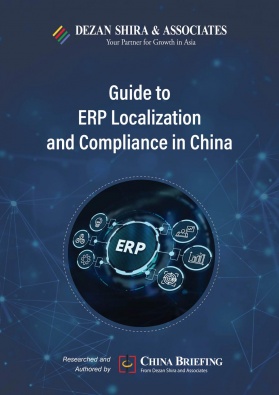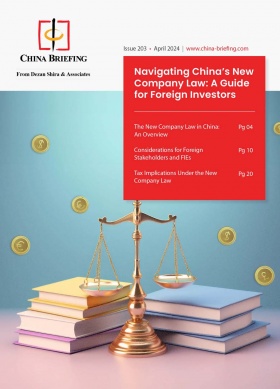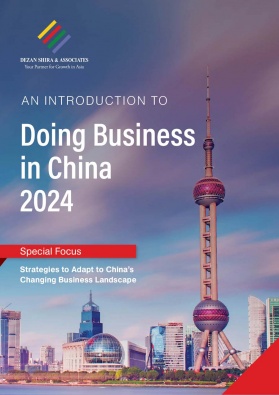New Business Prospects in China’s Waste Recycling Market
We discuss how establishing a waste recycling system is aligned with China’s broader conservation strategy and push for a circular economy.
China’s General Office of the State Council has issued the Opinions on Accelerating the Construction of a Waste Recycling System (the “Opinions”). The Opinions target waste across all sectors of production and daily life, presenting a comprehensive framework of policies to accelerate waste management and effective recycling. They outline key tasks and requirements for enhancing waste re-utilization, fostering the recycling of critical waste streams, and nurturing the growth of the resource recycling industry.
What are the goals of the Opinions?
The Opinions, guided by the principles of the circular economy—reduce, reuse, and resource—aim to optimize resource utilization efficiency. Implementing these directives will not only conserve resources but also encourage resource-intensive practices, enhancing overall efficiency, driving high-quality development, and promoting sustainable growth for the creation of a ‘beautiful China‘.
Establishing a waste recycling system is a crucial endeavor in line with China’s broader conservation strategy. It serves as a cornerstone in safeguarding national resource security, advancing towards carbon neutrality, and fostering a greener development model.
The Opinions require significant strides to be made towards establishing a waste recycling network covering diverse fields and major waste streams. This includes achieving an annual utilization of 4 billion tons of bulk solid waste and a 60 percent comprehensive utilization rate of new bulk solid waste by 2025. Additionally, the annual utilization of key renewable resources such as scrap metals and paper is targeted to reach 450 million tons, driving the resource recycling industry’s annual output value to RMB 5 trillion (US$695 billion).
By 2030, the focus will be on constructing a comprehensive, efficient, and standardized waste recycling system, maximizing the resource value of various waste types, and further increasing the proportion of renewable materials in raw material supplies. This effort aims to significantly enhance both the scale and quality of the resource recycling industry, positioning waste recycling practices among the world’s leading standards.
What are the general requirements of the Opinions?
The waste management strategy in China prioritizes systematic planning, precise policy categorization, innovation-driven approaches, and a balance between government guidance and market leadership. This approach aims to leverage the market’s role in resource allocation while establishing supportive policy frameworks to stimulate participation and drive momentum in waste recycling efforts. Key enterprises are expected to lead by example in driving these initiatives forward and to increase the use of recycled materials, incorporating their application into corporate social responsibility initiatives.
The Opinions outline five key tasks and policy initiatives:
- Firstly, efforts will concentrate on promoting fine management and effective recycling, employing tailored measures for different waste sources, such as industrial, agricultural, and social waste.
- Secondly, there will be a focus on enhancing waste resource utilization and reuse through measures, such as comprehensive bulk solid waste utilization and promoting second-hand commodity trading.
- Thirdly, emphasis is placed on strengthening the recycling of key wastes, including used power batteries and low-value recyclables.
- Additionally, the strategy aims to cultivate the resource recycling industry by promoting industrial agglomeration and fostering industry-leading enterprises.
- Finally, there is a focus on improving policy mechanisms to overcome barriers, including enhancing support policies and promoting the application of recycled materials.
Types of waste targeted
Industrial waste
The Opinions aim to promote classification and storage of industrial solid waste to prevent mixing and facilitate resource recycling. They advocate for comprehensive mapping and rectification of historical solid waste dumps, urging large storage enterprises to enhance resource recycling efforts. Moreover, the Opinions suggest improving industrial wastewater treatment facilities and encouraging cooperation between waste-generating and utilization units.
Agricultural waste
The Opinions propose improving agricultural waste collection by establishing livestock and poultry manure treatment systems and enhancing straw collection methods. They encourage the recycling of waste agricultural materials like agricultural film and machinery. The Opinions also highlight the importance of enhancing the role of supply and marketing cooperation systems in waste recycling networks.
Social source waste
The Opinions promote social source waste classification and recycling by encouraging domestic waste sorting. The Opinions advocate improving recycling networks for household items and electronics, integrating waste systems, especially in rural areas. They suggest revising construction waste regulations, promoting public institutions’ leadership in recycling. Additionally, the Opinions endorse “Internet + recycling” models, urge reverse logistics recycling, and support urban waste recycling and sewage network construction.
Broader background of the policy
The Opinions come under a broader policy background as China strengthens its environmental framework with new laws and regulations. Recycling plays a vital role in China’s transition to a green, low-carbon, and circular economy, especially for China’s carbon peak and carbon neutral objectives. China Circular Economy Association forecasts that it could reduce carbon emissions by over 30 percent by 2025 and up to 35 percent by 2030.
In March 2017, China introduced waste sorting plans aimed at recycling 35 percent of waste in 46 major cities. Subsequently, following the issuance of the “Work Plan on “Zero-waste City” Pilot Program in China” by the General Office of the State Council in 2018, numerous cities and special areas, such as Shenzhen and Xiong’an New Area, actively engaged in reform trials, yielding significant results. In July 2019, Shanghai became the first city to have a mandatory waste-sorting policy. After that, this initiative gained further traction during the 14th Five-Year Plan period, with plans to extend the concept to 113 cities and 8 special areas. Presently, waste sorting is mandatory in most major Chinese cities, leading to a substantial reduction in waste sent to incineration or landfill.
Also initiated in 2017, China’s waste import ban prohibited the importation of foreign waste products. Specifically aimed at plastics with contamination levels surpassing 0.05 percent, this ban significantly impacted global recycling industries.
The National Development and Reform Commission (NDRC) released the Development Plan for the Circular Economy in the 14th Five Year Plan Period on July 7, 2021, underscoring the importance of recycling in maximizing resource utilization and product lifecycle. The plan outlines targets to be achieved by 2025 (similar to the targets set forth in the Opinions), including reaching utilization rates of 86 percent for crop stalks, 60 percent for bulk solid waste, and 60 percent for construction waste. Additionally, it aims to utilize 60 million tons of wastepaper, 320 million tons of scrap steel, and produce 20 million tons of recycled non-ferrous metals. Furthermore, the plan commits to developing recycling parks, enhancing recycling and utilization of electrical waste and electronic products, and promoting the recycling of used batteries.
Meanwhile, as China’s industrialization and urbanization continue to progress, the scale and complexity of municipal waste production increase, alongside challenges in waste recycling pathways and gaps in policy mechanisms. Enhancing waste recycling infrastructure becomes increasingly vital and urgent to address these challenges and maximize resource utilization capabilities.
China’s waste recycling market
According to the Report on the Development of China’s Recycling Industry from China Materials Recycling Association, the total amount of recycling of 10 major varieties of renewable resources was about 371 million tons and the total amount of recycling was RMB 1.31 trillion (US$18 billion) in 2022. The main categories of renewable resources recycled in China include scrap iron and steel, waste non-ferrous metals, waste plastics, wastepaper, waste tires, waste electrical and electronic products, end-of-life motor vehicles, waste textiles, waste glass and waste batteries, and other categories.
Over the past decade, the scale of China’s renewable resources industry has expanded significantly. Recycling enterprises exceeded 90,000, dominated by small and medium-sized enterprises, and employing about 13 million people.
However, the recycling volume of certain renewable resource categories declined in 2022 due to domestic and international economic conditions, decreasing commodity prices, and other factors. Consequently, recycling prices fell, leading to an overall 4.0 percent year-on-year decline in China’s total recycling amount. Notably, waste glass, waste textiles, and WEEE (Waste Electrical and Electronic Equipment) are witnessing the most significant drops, with respective decreases of 15.4 percent, 12.6 percent, and 10.4 percent, respectively.
Challenges in developing China’s waste recycling market
While the renewable resources industry has made strides in system improvement, challenges persist. Insufficient coverage of recycling outlets and a lack of standardization remain significant bottlenecks in the industry’s development.
The level of waste resource utilization in China remains relatively low. According to research from the Tsinghua University, recycling rates for domestic waste in pilot cities stand at 36 percent, construction waste utilization hovers around 50 percent, and [mine] tailings utilization is at 32 percent, indicating significant room for improvement. Despite producing 3.65 million tons of recycled copper, 8.0 million tons of recycled aluminum, and 2.7 million tons of recycled lead in 2021, the focus remains on medium- and low-end resource utilization, with limited improvement in the value-added of comprehensive utilization products. Challenges persist in recycling emerging waste, such as power batteries, photovoltaic components, and wind turbines, with insufficient precision in rare metal sorting to meet industrial material application standards.
Insufficient recycling outlets hinder the renewable resources recycling industry’s progress. Most recycling sites are in urban areas, leading to low coverage and issues like inadequate equipment and transportation challenges. Rural and urban-rural areas face even greater difficulties accessing recycling channels, hampering resource recovery efficiency.
The standardization of China’s second-hand market also remains inadequate. While the market offers an increasingly diverse range of goods and transactions are growing, it remains in its early stages. A standardized system for pricing, trading, and after-sales service is yet to be fully developed. Further, more than 80 percent of recycling enterprises are small to medium-sized, facing limitations in technology and costs. This leads to common practices of rudimentary dismantling and chaotic disposal, causing “secondary pollution” and decreasing product value. These factors contribute to competition homogenization, impeding product quality improvement and industry development.
Foreign investment potential
China’s environmental and climate objectives are generating new opportunities across various sectors, driven by advancements in technology, finance, and regulation. Businesses operating within the recycling industry, spanning research and development (R&D) of recycling technologies and manufacturing of recycling equipment, are poised to benefit from expanding market prospects in the medium to long term.
Attractive opportunities include waste treatment and recycling of electronic products, automobiles, plastics, building materials, and textiles. Additionally, there are opportunities in manufacturing equipment for recycling and remanufacturing, as well as for developing technologies related to energy conservation, environmental protection, and comprehensive resource utilization. China’s recycling sector offers foreign firms a chance to contribute to environmental sustainability while tapping into a growing market.
About Us
China Briefing is one of five regional Asia Briefing publications, supported by Dezan Shira & Associates. For a complimentary subscription to China Briefing’s content products, please click here.
Dezan Shira & Associates assists foreign investors into China and has done so since 1992 through offices in Beijing, Tianjin, Dalian, Qingdao, Shanghai, Hangzhou, Ningbo, Suzhou, Guangzhou, Dongguan, Haikou, Zhongshan, Shenzhen, and Hong Kong. We also have offices in Vietnam, Indonesia, Singapore, United States, Germany, Italy, India, and Dubai (UAE) and partner firms assisting foreign investors in The Philippines, Malaysia, Thailand, Bangladesh, and Australia. For assistance in China, please contact the firm at china@dezshira.com or visit our website at www.dezshira.com.
- Previous Article China’s New Measures to Support Foreign Investment in Sci-tech Firms
- Next Article Understanding the Relaunched China Certified Emission Reduction (CCER) Program: Potential Opportunities for Foreign Companies








